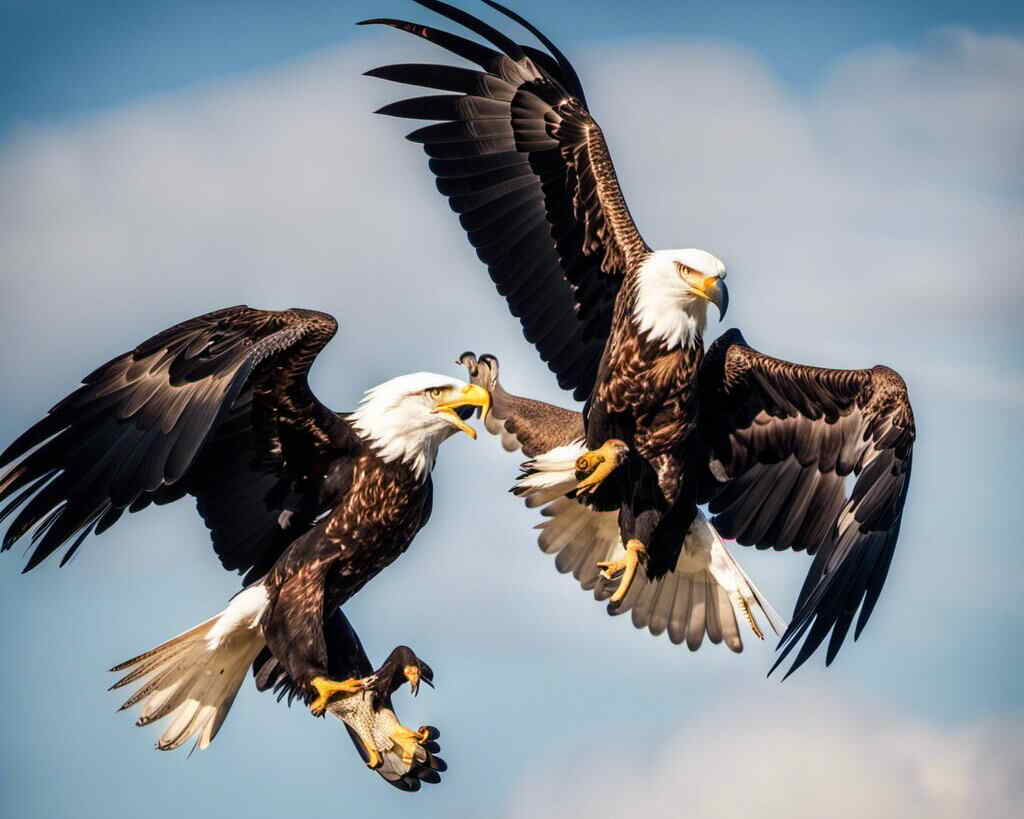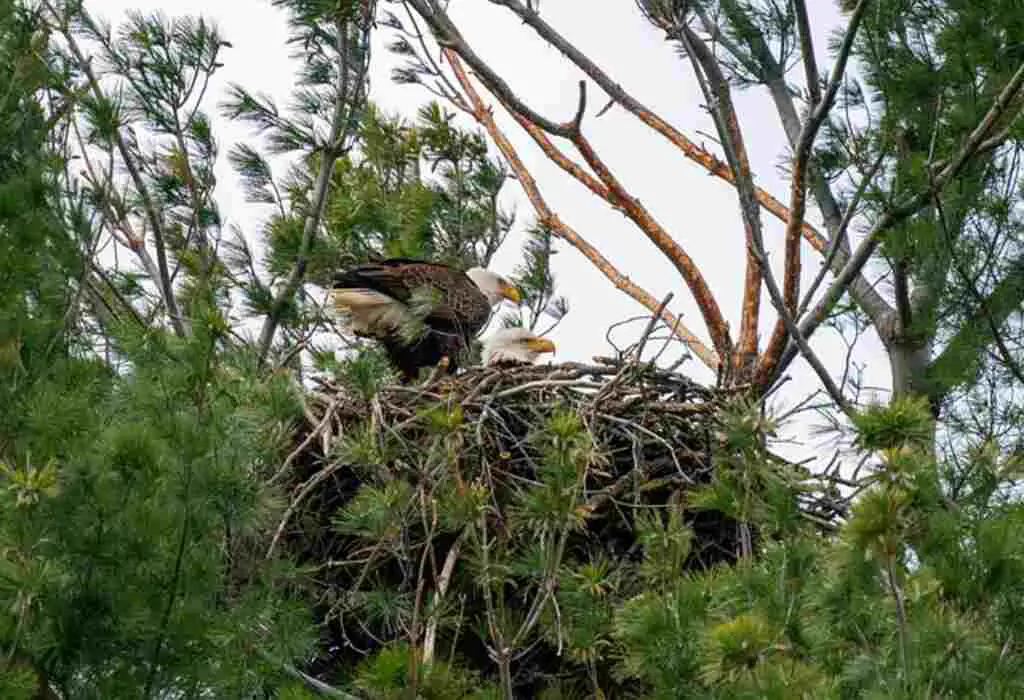Prepare to embark on an exhilarating journey into the lives of Pennsylvania’s magnificent eagles! As the majestic birds soar high above the scenic landscapes, one question echoes across the state: “When do eagles mate in Pennsylvania?”
Brace yourself for an awe-inspiring adventure as we delve into the fascinating world of these regal creatures and unveil the captivating rituals of their mating season.
From heart-pounding aerial acrobatics to tender courtship displays, join us in unraveling the hidden wonders of these winged wonders in the Keystone State.
Get ready to witness nature’s most breathtaking spectacle, right here in the heart of Pennsylvania!
Table of Contents
- 1 Key Takeaways
- 2 When Do Eagles Mate In Pennsylvania?
- 3 Overview of Pennsylvania’s Eagle Population
- 4 The Importance of Eagle Mating Season
- 5 Understanding Eagle Courtship Behaviors
- 6 Timing of Eagle Mating Season in Pennsylvania
- 7 Nesting and Egg-Laying Process
- 8 Incubation Period and Parental Care
- 9 Hatching and Rearing of Eaglets
- 10 Challenges and Threats to Eagle Reproduction
- 11 Conservation Efforts to Protect Eagles in PA
- 12 The Role of Citizen Science in Monitoring Eagle Populations
- 13 Conclusion: Celebrating the Majesty of Eagles in Pennsylvania
- 14 FAQs: When Do Eagles Mate In Pennsylvania?
- 14.1 How long does the eagle mating season last?
- 14.2 Are there any specific behaviors eagles exhibit during courtship?
- 14.3 What are the biggest threats to eagle reproduction in Pennsylvania?
- 14.4 How long does the incubation period last for eagle eggs?
- 14.5 How do citizen scientists contribute to monitoring eagle populations in Pennsylvania?
- 15 Author
Key Takeaways
- Eagle mating season in Pennsylvania occurs between February and April.
- Eagle courtship behaviors include aerial displays, vocalizations, nest building, and food exchange.
- Understanding eagle courtship behaviors is essential for conservation efforts.
- The timing of eagle mating season is influenced by factors such as day length, weather conditions, and food availability.
When Do Eagles Mate In Pennsylvania?
In Pennsylvania, eagles typically mate from late December to early January, with nesting activity starting one to three months before the female lays eggs. However, the exact timing can vary depending on the location and weather conditions. Eagles tend to mate for life, and if one partner dies, the other quickly finds a new mate if one is available.
Overview of Pennsylvania’s Eagle Population
Pennsylvania’s eagle population has experienced a significant resurgence in recent years, making it an ideal location to study the mating habits of these majestic birds.
With a steady increase in numbers, the state now boasts one of the largest populations of eagles in the United States.
Understanding the eagle courtship behaviors is essential to comprehending their mating patterns.
Eagles typically engage in elaborate courtship displays, including aerial acrobatics, soaring together, and vocalizing. These behaviors serve to establish and strengthen pair bonds.
Mating season for eagles in Pennsylvania typically occurs between February and April, with peak activity in March. During this time, eagles build or repair their nests and engage in courtship rituals.
The importance of eagle mating season extends beyond reproduction, as it also plays a crucial role in shaping their overall population dynamics and conservation efforts.
The Importance of Eagle Mating Season
During the designated period, the annual eagle mating season in Pennsylvania serves a significant purpose in ensuring the continuation of the species, exhibiting a remarkable display of courtship rituals that captivates observers statewide.
1) Eagle mating rituals are crucial for successful reproduction and maintaining a healthy population.
2) These behaviors allow eagles to establish pair bonds and select suitable mates.
3) The courtship displays, such as aerial acrobatics and vocalizations, serve to communicate the eagles’ readiness to breed and attract potential partners.
Understanding eagle courtship behaviors is essential for conservation efforts and management strategies. By studying their mating rituals, researchers gain insight into the health and behavior of the eagle population.
This knowledge can help in protecting their habitats, promoting breeding success, and ensuring the long-term survival of these majestic birds.
Transitioning into the subsequent section, a deeper understanding of eagle courtship behaviors provides valuable information about their reproductive strategies.
Understanding Eagle Courtship Behaviors
An in-depth examination of eagle courtship behaviors provides valuable insights into their reproductive strategies and contributes to the broader understanding of avian mating rituals.
Eagle courtship rituals are fascinating and complex, involving a variety of behaviors that serve to establish and strengthen the bond between mates.
These rituals often involve elaborate aerial displays, with both male and female eagles engaging in impressive flight maneuvers.
Additionally, courtship behaviors may include mutual vocalizations, nest building, and the exchange of food or nesting materials.
The table below highlights some of the key courtship behaviors exhibited by eagles:
| Behavior | Description |
|---|---|
| Aerial displays | Impressive flight maneuvers, such as soaring, diving, and chasing, performed by both male and female |
| Vocalizations | Mutual calls and vocal exchanges between mates |
| Nest building | Construction or renovation of the nest by both male and female eagles |
| Food exchange | Offering of food by the male to the female during courtship |
Understanding these courtship behaviors is crucial for comprehending the timing of eagle mating season in Pennsylvania, which will be discussed in the subsequent section.
Timing of Eagle Mating Season in Pennsylvania
The timing of eagle mating season in Pennsylvania has long been a subject of interest among researchers, prompting the question: What environmental factors influence the onset of courtship behaviors in these majestic birds?
Understanding the timing of eagle mating is crucial for conservation efforts and monitoring the health of the eagle population.
In Pennsylvania, eagles typically begin their courtship behaviors in late December to early January, with peak mating occurring in February and March.
The onset of courtship is thought to be influenced by factors such as day length, weather conditions, and food availability.
As the days grow longer and temperatures become milder, eagles engage in elaborate aerial displays and vocalizations to attract potential mates.
This timing ensures that the eggs are laid and incubated during the optimal conditions for successful hatching and fledging.
Transitioning to the subsequent section about the nesting and egg-laying process, eagles meticulously construct their nests and carefully lay their eggs.
Nesting and Egg-Laying Process
Nesting and egg-laying in eagles involves a meticulous construction of nests and a careful process of laying eggs. Eagles typically build their nests on high trees or cliffs, using sticks and other materials.
The male and female eagles work together to build a sturdy nest, which can be used year after year.
The mating rituals of eagles are complex and involve elaborate aerial displays, vocalizations, and courtship flights.
Once the nest is ready, the female eagle will lay one to three eggs, usually a few days apart. The eggs are incubated for about 35 days, during which both parents take turns keeping them warm and protected.
After the eggs hatch, the parents provide constant care and protection to the young eaglets, ensuring their survival and growth.
This careful nesting and egg-laying process sets the stage for the subsequent incubation period and parental care.
Incubation Period and Parental Care
During the incubation period, the male and female eagles take turns diligently maintaining the warmth and protection of the eggs, displaying a level of dedication that would make even the most devoted helicopter parents blush.
The incubation period for bald eagles in Pennsylvania typically lasts for around 35 days. The male and female eagles work together to ensure a constant temperature for the developing embryos, rotating responsibilities for incubation.
While one parent is incubating the eggs, the other is engaged in activities such as hunting or defending the nest territory. The incubating bird carefully turns the eggs to prevent the developing embryos from sticking to the shell, ensuring their proper development.
The parents also provide protection from predators and adverse weather conditions during this critical period. Once the eggs hatch, the next phase of the eagles’ parental care begins, as they shift their focus to the hatching and rearing of eaglets.

Hatching and Rearing of Eaglets
After the incubation period, the eagles shift their focus to the hatching and rearing of the newly-hatched eaglets, demonstrating their commitment to ensuring the survival and development of their offspring.
During this critical phase, the eagles exhibit specific behaviors that contribute to the successful rearing of their young.
- Hatching Challenges: The eggs require a specific temperature and humidity for successful hatching. The parents carefully regulate the nest conditions, using their bodies to provide warmth and adjusting the positioning of the eggs to maintain optimal conditions.
- Eagle Behavior during Rearing: Both parents actively participate in feeding and protecting the eaglets. They tear small pieces of prey and provide it to the young. The parents also shield the eaglets from extreme weather conditions and potential predators, ensuring their safety and well-being.
- Transition: Understanding the challenges and behaviors during the hatching and rearing process is crucial to comprehending the subsequent section about challenges and threats to eagle reproduction.
Challenges and Threats to Eagle Reproduction
Adversities and dangers persistently loom over the process of eagle reproduction, casting a shadow of uncertainty on the future of their offspring. Eagles face numerous challenges and threats that hinder successful reproduction and survival.
Habitat loss and fragmentation pose significant challenges, as they limit suitable nesting sites and hunting grounds for the eagles.
Pollution, particularly contamination of water bodies, can negatively affect their reproductive success by reducing prey availability and causing eggshell thinning.
Additionally, human disturbance, such as noise and disturbance near nesting sites, can lead to abandonment of nests or the failure of incubation.
Climate change is another emerging threat, impacting eagle reproduction through altered weather patterns and changes in prey availability.
These challenges and threats highlight the need for conservation efforts to protect eagles in PA, ensuring their continued survival and reproductive success.
Conservation Efforts to Protect Eagles in PA
Conservation efforts play a crucial role in safeguarding the future of eagle populations in Pennsylvania, ensuring their long-term survival and reproductive success. To protect these majestic birds, several initiatives have been implemented:
- Habitat Conservation: Efforts are focused on preserving and restoring suitable nesting habitats for eagles. This includes protecting large tracts of forested land and wetlands, which are vital for their breeding and foraging activities.
- Wildlife Management: Conservationists work closely with wildlife agencies to regulate hunting and fishing practices that could potentially harm eagles or deplete their prey species.
- Education and Outreach: Public awareness campaigns aim to promote responsible eagle-watching practices and encourage individuals to report any potential threats or disturbances to nesting sites.
- Collisions and Electrocutions Prevention: Efforts are made to mitigate the risk of eagle collisions with power lines and structures by implementing measures such as retrofitting poles with perch deterrents and installing bird-friendly power lines.
- Law Enforcement: Strict enforcement of laws and regulations, such as the Bald and Golden Eagle Protection Act, helps deter illegal activities like nest disturbance or shooting.
These conservation efforts are vital for the protection of eagles in Pennsylvania and ensure their continued presence in the state’s ecosystems.
Transitioning to the subsequent section on the role of citizen science in monitoring eagle populations, it is important to understand how these efforts are evaluated and their impact assessed.

The Role of Citizen Science in Monitoring Eagle Populations
Citizen science initiatives have proven to be invaluable in monitoring eagle populations, with over 500 active nests documented in Pennsylvania as reported by the Pennsylvania Game Commission in 2020.
Citizen involvement in data collection allows for a more comprehensive understanding of eagle populations and their habitats.
By engaging citizens in the monitoring process, a larger amount of data can be collected over a wider geographic area, providing a more accurate representation of eagle populations in Pennsylvania.
This approach also fosters a sense of ownership and responsibility among citizens, encouraging them to actively participate in conservation efforts.
The use of citizen science not only increases the quantity of data collected, but also enhances the quality and reliability of the information.
By harnessing the power of citizen involvement, we can better protect and celebrate the majesty of eagles in Pennsylvania.
Conclusion: Celebrating the Majesty of Eagles in Pennsylvania
In conclusion, the remarkable resurgence of eagle populations in Pennsylvania serves as a testament to the successful implementation of conservation efforts and the importance of monitoring their habitats.
The celebration of eagles in Pennsylvania is not just limited to their population increase, but also extends to their mating season.
The eagle mating season typically occurs during the winter months, with courtship and pair bonding taking place from December to January.
Eagles are known for their majestic courtship displays, which involve aerial acrobatics, calling, and gift exchanges between the male and female.
These displays are a sight to behold and a true testament to the beauty and power of these magnificent birds.
As eagles continue to thrive in Pennsylvania, it is important to appreciate and celebrate their mating season as a symbol of their successful conservation and the awe-inspiring nature of these creatures.

FAQs: When Do Eagles Mate In Pennsylvania?
How long does the eagle mating season last?
The eagle mating season typically lasts for several months, and during this time, eagles engage in courtship rituals. Breeding success rates vary depending on factors such as food availability and habitat conditions.
Are there any specific behaviors eagles exhibit during courtship?
Eagle courtship rituals are a captivating dance, a choreography of aerial displays and symbolic exchanges. Mating habits include elaborate nest-building, vocalizations, and synchronized flights, all designed to strengthen the bond between partners and ensure successful reproduction.
What are the biggest threats to eagle reproduction in Pennsylvania?
The biggest threats to eagle reproduction in Pennsylvania include habitat loss and pollution. These factors can negatively impact the availability of suitable nesting sites and food sources, ultimately affecting the success of eagle mating and breeding.
How long does the incubation period last for eagle eggs?
The incubation period for eagle eggs typically lasts around 35 days. During this time, the eggs are kept warm and protected by the parent eagles until they hatch. This crucial period ensures the development and survival of the eagle embryos.
How do citizen scientists contribute to monitoring eagle populations in Pennsylvania?
Citizen scientists play a crucial role in monitoring eagle populations in Pennsylvania. They contribute by collecting data on eagle sightings, nest locations, and behavior, providing valuable information for conservation efforts and understanding population trends.





